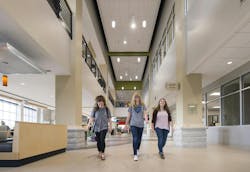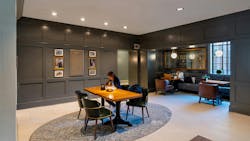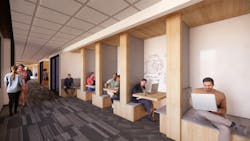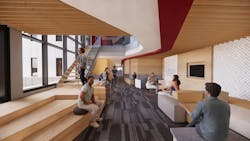Higher education design for the first-gen college student
College is a time for aspiring students to discover their identities, develop a career pathway, and find their place in the world. The transition from living at home through high school to living on-campus in college can be a difficult endeavor for any student. However, without familial mentors or advisors who have successfully navigated these onerous steps before can be an impossible undertaking.
As a first-gen student, I couldn’t rely on my parents or family members to forge my future, I had to design and build it myself. From applying for financial aid to finally reaching academic success in the form of a professional degree, the journey was an uphill battle.
So, what is it about first-gen students that makes it difficult for them to navigate through higher education?
First, let’s do a dive into who the first-generation college student is.
The phrase “first-gen” itself is often used to describe those students whose parents did not attend college or university and/or did not graduate with a bachelor’s degree.
Compared to continuing-generation students, first-gen college students are at a disadvantage even before transitioning from home to living on-campus. Prior to that, it should be acknowledged that the first-gen student meets their first hurdle in high school, at the college application process. Without a support system of individuals who underwent the process, there is no advice and no one to look up to for guidance. After acceptance, the student is torn between commuting and living on-campus. Some, but not all, first-gen students are managing a work life while studying and have family responsibilities they feel guilty shrugging off.
Buildings may not solve all the struggles of the first-gen student, but what can institutions do to address some of these challenges through architecture and design?
A shift in the institutional paradigm from a “college-ready” mentality expected of students to deliberately designed “student-ready” spaces is the first step to helping acknowledge the challenges first-gen students face when they arrive to campus.
1. Student housing has evolved over the last few decades.
The early 2000s saw a fad of extreme amenities like extravagant pools, rock climbing walls, and movie rooms. These efforts have since shifted to community spaces; fitness rooms; academic support spaces such as makerspaces or dance studio; meditation or yoga rooms; and the like- much more fitting to the upcoming Gen-Z student. Student housing with the first-gen first mentality would still aim to include more than the traditional dorm programming. Studies show that first-gen students tend to use less of the resources available to them on campus compared to their continuing-gen counterparts.
One such example are Health services. The lower usage from first-gen students is due to a lack of awareness. Bringing spaces less often used to the forefront and making them more visible can help these students be familiar with the services their campus provides that no one told them about. Many first-gen students also may not be aware of the academic help services or academic advising services. It can be the task of designers to signal at underutilized services through master planning or innovative programming that can impact students and bring these services that are student-focused to the forefront in student-housing planning and/or design.
2. Cost of living accommodations are a top consideration for many first-gen students when making decisions on choosing a college or even choosing to live on or off-campus.
The millennial generation was much more attracted to the living accommodations; however, this is not proven to lure students to choose a particular college today—the cost might. Designing highly efficient living-learning environments, thus lowering cost, allows the formative benefits of on-campus living to become accessible to more students.
3. Creating strong social and support networks, while keeping budget in mind is also key to the success of first-gen students.
Designing efficient bedroom and living layouts enables universities to reallocate that cost to community-centric spaces that enhance social wellness and boost the campus life experience for all students alike, without increasing the overall project cost. Community spaces are a need when it comes to designing with the “student-ready” or “first-gen first” mindset. The designer’s power is the ability to create spaces that encourage interaction. In the TED Talk by Amanda Burden, she discusses Paley Park, a pocket-park in New York City that is designed in an urban setting with minimal intervention; the space is fulfilled when it is used by its intended users and due to its location, it is. This idea of place-making is crucial when thinking about designing community spaces of any kind.
How will a student feel that sense of belonging in their residence hall?
Designing a range of differing styles of community spaces throughout the building allows multiple levels of interaction for students of all backgrounds. Students achieve success by networking with peers and meeting students outside their majors who they normally would not otherwise meet. The size, acoustics, volume, and aesthetics of the space makes all the difference.
Quieter spaces vs louder spaces or intimate spaces vs open spaces encourage multiple types of interaction that cater to numerous group sizes ranging from two-person to an entire living-learning community. Community spaces can also be used to highlight personalities of its residents. Having spaces that can be personalized is crucial in allowing the space to truly become theirs. This hierarchy of social spaces will fuel the social ambience of the spaces designed and make all students feel welcome and valued as residents.
As designers, we have much power when it comes to the interaction of people in spaces. A purposeful design with the emphasis on community can bear fruit in the form of new relationships amongst a building’s inhabitants. Designing with the first-gen first mentality allows design to shape the adventures of a new and eager college student, lower the stress of a worrisome parent, and reach to all students regardless of their backgrounds. It is time for designers to shift towards designing for “student-ready” spaces over “college-ready” students.
EXAMPLE 1:
University of St. Thomas Student Housing
In the metaphor of the city, first there are the households that each accommodate 8-10 students. Four of these household form the neighborhood with designated community spaces for each household pod. Two of the neighborhoods convene to create the district (or floor) with a central volume of space for all events. The spaces that connect two districts aid in creating this vertical city. In the design, the households serve as the most private community engagement areas and the central two-story community spaces acts as the most public.
As college students enter these spaces, they experience that vertical connectivity between floors which is crucial for each district (or floor) to allow students to convene and celebrate the end of midterms, rejoice on sporting wins, entertain one another, or simply be around others.
EXAMPLE 2:
Many universities aim to create spaces for students who have not had the opportunities to venture and explore outside of their own regions.
So how can institutions begin to create exceptional spaces for students, so they feel that they are really receiving a world-class experience?
Keeping in mind that not all students enter college with the same life-experience or means to access study-abroad programs also means there is a more critical need to bring those immersive cultural experiences to the college campus. This can be done through interactive learning spaces or enhanced conferencing abilities to bring the access to the student.
By becoming aware of different ways to help make first-gen college students thrive during their time at a college or university, we can be more proactive and find better solutions, such as design solutions. Even changes in the spaces that students will be living and learning will help them to find their place in the world and enjoy the college experience to the fullest.






